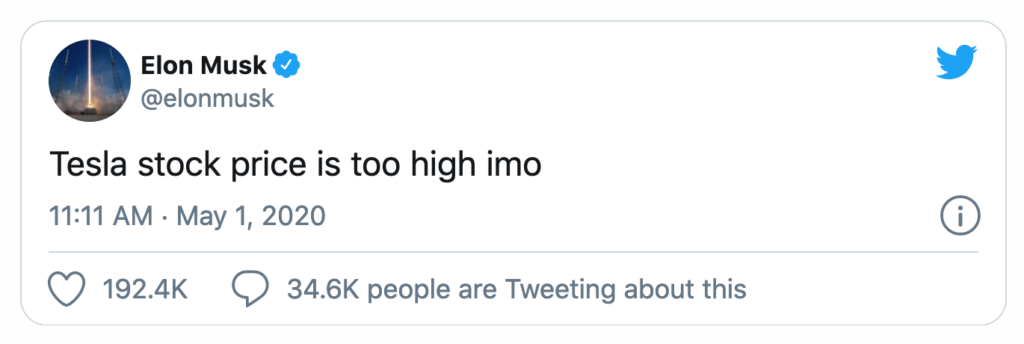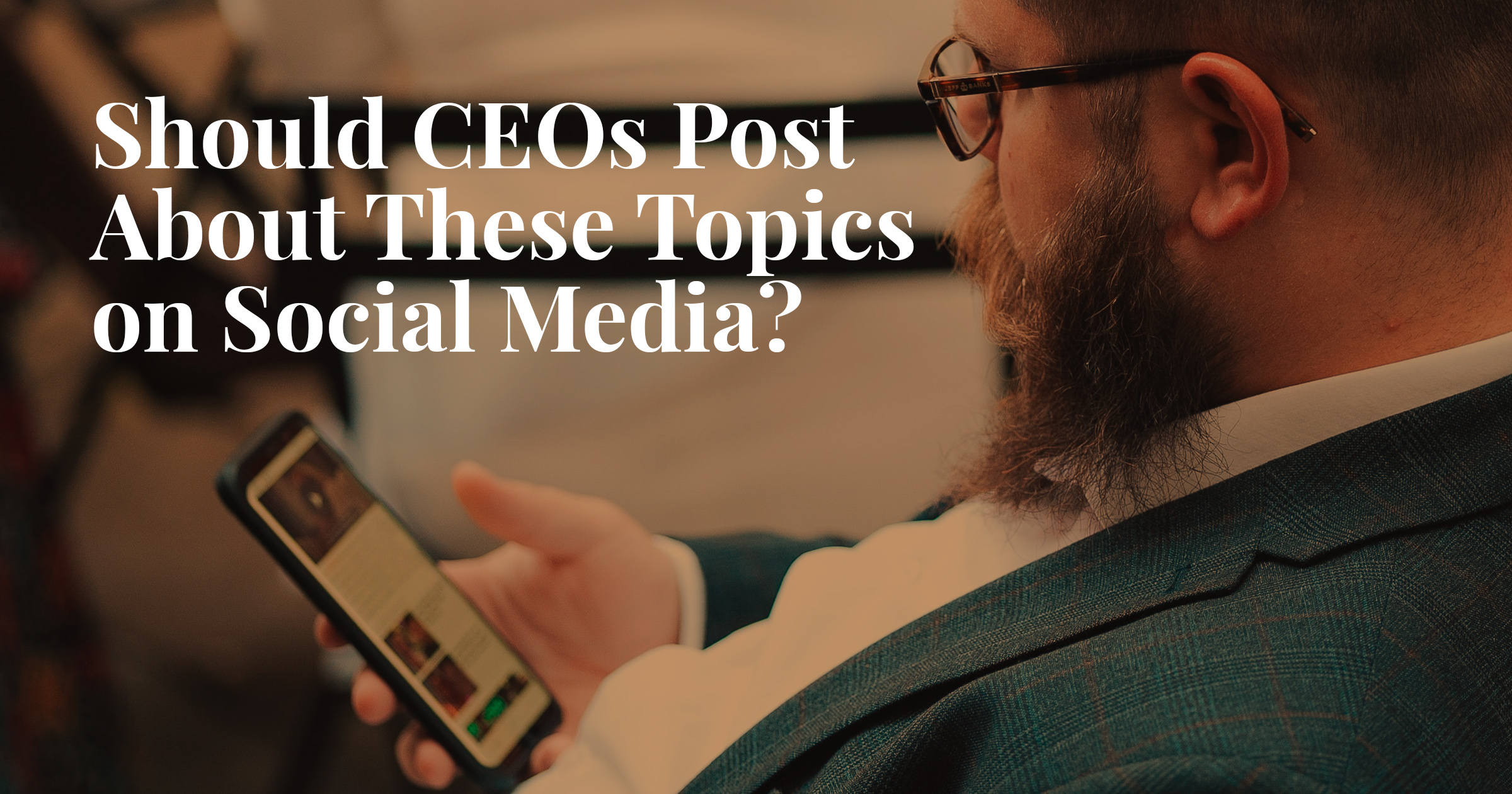Social media is a powerful tool. When used correctly, it can help CEOs connect with their audience, build their personal brand, and help their company reach its business goals.
However, social media is a public platform, and sometimes an executive’s message may be misconstrued by the general public, or a spur of the moment Tweet might hurt their company.
That being said, the benefits of having your company’s leadership team on social media far outweigh the risks. To learn more, take a look at Managing the Risks of Executive Social Media Presence, an article written by our CEO, Elissa Liu.
In this article, we look at three different topics that CEOs will want to be careful talking about on social media. We also look at examples of how social media posts have hurt brands in the past, and offer tips on how to avoid these situations.
Topics your company’s CEO will want to be careful with on social media
-
Should a CEO share their thoughts on politics, religion, and social issues?
-
Be cautious of discussing information related to your business
-
Knowing when to post personal content on social media
Should your CEO chime in on politics, religion, and social issues?
The general rule of thumb is that if the topic isn’t suitable to talk about at a dinner table among strangers, chances are it should be left off social media. There are ways to effectively discuss politics on social media (we’ll show an example below), but in general, politics and religion are subjects to be extremely cautious about.
However, social issues are an area that many CEOs are discussing on social media to great success. From climate change to the #BlackLivesMatter movement, social media has become one of the primary ways for executives to voice their support. Take a look at our article, Executives Supporting #BlackLivesMatter, to see how platforms like LinkedIn can promote social causes.
While executives are encouraged to share their support on social media, there are times when discussing social causes led to intense scrutiny. For example, CrossFit’s former CEO, Greg Glassman, resigned after posting insensitive Tweets related to the death of George Floyd and the COVID-19 pandemic. Reebok, one of CrossFit’s key partners, ended its partnership shortly after. The team at CrossFit would later release a public statement on the company blog, but the damage had already been done.
Our advice?
When speaking about important issues, it’s important to take a stance. Now more than ever, consumers expect companies to support social causes and may even base their purchasing decision on companies whose values align with their own.
While politics can be a touchy topic to discuss on social media, there are ways to do so effectively. For example, during the U.S. elections in November 2020, many executives took to social media to encourage people to vote (visit our article, Executives Using Their LinkedIn Presence to Promote Democracy, to learn why this was an important step for executives to make). Rather than lean towards one political party or another, executives instead focused on democracy and the importance of voting. This was a neutral stance with messaging that resonated among the audience, regardless of the political party they supported.
Discussing your business on social media could come with a high price tag
How much does it cost to post a Tweet on a CEO’s account? Nothing.
How much can a Tweet cost a company? Billions.
Elon Musk and Tesla found out the hard way when the CEO made this Tweet in May 2020:

[Source]
The BBC reports that Musk’s Tweets lowered Tesla’s valuation by $14 billion USD, while Musk’s stake in the company dropped by $3 billion. This isn’t the first time he has found himself in hot water on social media. One of his previous Tweets joking about taking Tesla private at $420 a share landed him a $20 million fine (although he would later claim that the Tweet was “worth it”).
Worth it
— Elon Musk (@elonmusk) October 27, 2018
Depending on what industry your company’s CEO is in, there may be set guidelines that limit or restrict what can or can’t be posted on social media. For example, the U.S. Food & Drug Administration (FDA) features several pages on how social media should be used.
Our advice?
For CEOs in highly regulated industries, such as finance and healthcare, speak to your compliance team to learn more about what can or can’t be posted on social media. This can then inform your digital marketing strategy on how best to position your company’s executives.
Even though Musk’s $420 stock price Tweet was a joke, it still violated the rules around how a company’s financial information can be shared with the public. There are ways for a CEO to discuss their business in a more effective way that appeals to stakeholders while ensuring the content is within the industry’s guidelines.
For example, Delta Air Lines CEO, Ed Bastian, often discusses his company’s values and mission statement. Mary Barra, the CEO of General Motors, uses her social media presence to talk about her company’s commitment to innovation. Both of these methods help strengthen the brand’s image among their respective audiences.
Should your CEO post personal content on social media?
While many executives establish a social media presence to help their company achieve specific goals, others might use their accounts to post more personal content. From sharing photos of a birthday celebration to workout routines, it’s not uncommon for executives to use social media as a way to share their hobbies and what they do when they’re not at work.
While posting personal content on social media is perfectly fine, there are some caveats, as Amazon’s founder and CEO, Jeff Bezos, found out when he posted the Tweet seen below.
Dog sledding above the Arctic Circle in Norway. Jim Lovell says it’s not that you go to heaven when you die, but “you go to heaven when you’re born.” Earth is the best planet in our solar system. We go to space to save the Earth. @BlueOrigin #NoPlanB #GradatimFerociter #EarthDay pic.twitter.com/q0Y9A4KSLm
— Jeff Bezos (@JeffBezos) April 22, 2018
At a glance, the video seems rather innocuous—it’s an executive sharing a clip from his vacation. However, given that Amazon had been receiving negative press due to its treatment of employees, the timing of the post led to a major backlash. Others criticized using a vacation video to highlight his messaging and the fact that showing off his vacation was in poor taste if he wanted to make an impact in preventing climate change.
Our advice?
While sharing personal photos and videos may seem straightforward and innocent for CEOs, it’s important to think about the post in the context of the company. What’s the current sentiment surrounding the company? If it’s negative, what are the key reasons? Can a CEO use their social media presence to address these issues?
Even for posts that aren’t directly related to their company or achieving business goals, CEOs must still be strategic when it comes to posting personal content. As the public face for their company, the content that goes out on an executive’s social media account can have a great impact on the company.
Always keep this in mind: social media is a public forum
Because the identity of the CEO is deeply connected to the company’s image, it’s important to develop a strong social media strategy to mitigate risks, such as posting content at the wrong time or posting content that shouldn’t be shared with the public.
While a post can be deleted and taken down, this shouldn’t be the main solution to fix social media mishaps. Instead, executives who use social media should consult with their in-house marketing team or an external agency experienced in digital marketing. This is an effective way to set guidelines on how to best use a CEO’s online presence.
If your company is looking to position its leadership team on social media, let’s talk! Click the button below and connect with one of our executive marketing strategists to determine what company goals your executive’s social media presence can achieve.
href="#" data-color-override="false" data-hover-color-override="false" data-hover-text-color-override="#fff">Book a 30-minute consultation


